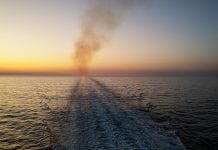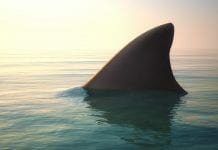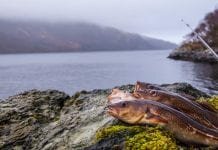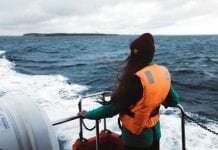
The Institute of Fisheries Management (IFM) is an international organisation of those sharing interests in the modern management of recreational and commercial fisheries. Robert Clark, a member of the IFM, discusses the future of fisheries.
No other group of animals is as difficult to manage as fish, but technology is providing solutions to the challenge of sustainable fisheries management. Novel technologies at the frontier of science have an important role in assisting in the challenges of fisheries management; from the use of DNA in supporting the development of stock assessments to satellites combating illegal fishing.
The size of the (fish) cake
The Food and Agricultural Organisation estimate that globally, some 91-93 million tonnes of fish are captured each year, and seafood products are among the world’s most widely traded food commodities, with an export value of $142 billion (~€114.9) in 2016. Fish is the means of subsistence for billions of people around the world.
In 2014, the EU’s fishing fleet generated €7.2 billion and the livelihoods of many EU citizens depend on the sea and its resources. There are 100,000 vessels registered in the EU and combined, these catch some 6.4 million tonnes of fish. Around 80% of this capture is caught from the wild and the remainder from aquaculture.
“If you can’t measure it, you can’t manage it”
Fish and shellfish are hidden from view, but understanding what harvest is sustainable requires an estimation of the abundance of fish. Unlike terrestrial wildlife, fishery managers cannot look into the ocean and count the fish that they see. Instead, they must try to estimate the size of fish stocks as accurately as possible, based on sub samples of the population.
Traditionally using techniques with origins in the management of whaling, fisheries management has largely been focused in single species stock assessments. However, with the increased computing power now readily available, stock assessments are moving to ‘ecosystem assessments’; ecosystem assessments take into account the interconnectedness of fish food webs and the influences of factors such as weather.
In this regard, molecular biology – the detection of adaptive diversity (outlier loci) – provides unprecedented opportunities to understand bio-complexity in the near future; fisheries sciences may integrate evolutionary principles with fisheries management to assess the potential effects of fishing or climate change on the resilience of fisheries stocks.
- The advent of sonar and positioning systems – a technology adapted from military use – marked a significant turning point in the race to fish.
- Fish shoals and fishing marks, which were previously known through traditional methods, were more readily available to the fishing industry, increasing efficiency and contributing to a decline in many fish stocks. Today, these technologies are also used by scientists and managers, in order to map stocks and fish habitats.
- Multibeam sonar can provide intricate three-dimensional maps of the seabed, enabling managers to map ‘essential fish habitat’, such as areas important for fish reproduction. This facilitates the identification of sensitive marine areas where fishing could damage precious habitats.
- Increasingly ‘Autonomous Underwater Vehicles’ – unmanned submarines – are being deployed to gather this type of data and to routinely map areas of seabed.
Small fish in a big pond
Differing species of fish exhibit complex life histories. Advances in technology are assisting in answering some of the most illusive questions in fisheries management, such as where do certain fish go? Many fish migrate, some across oceans, and some, such as salmon and seatrout, across both fresh and salt water.
So as to manage and protect fish stocks at vulnerable periods of their lifecycle, firstly we must know where they travel. Here high-throughput, also known as next generation, DNA sequencing is providing answers. The technique allows us to sequence DNA and RNA much more quickly and cheaply than previous methods; it is transforming genomics and molecular biology.
Research is now being conducted on which fish live where, based on DNA in the water. As fish move through the water they shed cells, such as scales and by measuring the presence and diversity of cells in the water it is possible to detect the presence or passage of animals. Where before fisheries managers relied on costly research vessels, using modified commercial fishing techniques, new approaches to the use of ‘environmental DNA’ are providing rapid and affordable techniques to understand whether, and in what abundance, fish have been in the water column.
Individual fish are also being tracked to provide insights into their migration and movements. Pictures of fish migrations have previously been built from models of incidences of capture and left large gaps in our knowledge for many species. The development of pop-up satellite archival tag (PSAT) technology – tags inserted or attached to fish – are helping to improve the acquisition of this information and revolutionising investigations into the distribution of migratory species.
The race for space
As well as assisting in where fish live and move from and to, technology is aiding in mapping and monitoring fishing activity. Monitoring where, when, and how, fishing fleets are operating has traditionally relied upon self-reporting and fisheries monitoring using ships, aerial assets and port inspection. Yet once over the horizon, monitoring of fishing vessels is costly and difficult.
Today, satellites are routinely used to aid the monitoring of fishing activity. In Europe, all vessels over 12 meters in length are required to operate a vessel monitoring system (VMS). These systems send the location speed and direction of a fishing vessel via satellite to control authorities. The technology is also available to (smaller) inshore fleets, which operate closer to land, utilising the mobile phone network. This use of technology greatly reduces compliance costs and provides managers with a much better understanding of the distribution of fishing activity. This is particularly helpful in ensuring that certain habitats in ‘marine protected areas’ are not damaged.
The NASA-NOAA Visible Infrared Imaging Radiometer Suite (VIIRS) can detect lit fishing boats at night and this technology is being used to detect fishing in the further reaches of our oceans, for instance in areas far from routine monitoring, and often outside states fisheries controls.
What’s the catch?
In addition to the target species, other marine fish and animals may be caught; if discarded, this practice is wasteful and if protected species are caught it can threaten conservation efforts. Traditionally, fisheries observers would be deployed to monitor activities, but the cost and the conditions mean that only limited observations can be made.
Through implementation of low-cost, high-quality camera and data storage devices, nets and fishing operations can be monitored to provide an accurate estimate of the bycatch. The vast data generated through such systems can be analysed with the assistance of artificial intelligence, whereby computers are trained to seek certain patterns in the catches. This data can then inform management of fishing gear design or fish allocation in certain areas, so as to minimise unwanted bycatch and protect the environment.
What’s in a label?
Fish is big business and the supply chain is complicated and the potential for fraud exists. In 2010, one EU study found that in up to 40% of cases the fish consumers thought they were buying was mislabelled and was substituted for other species. The incentives to do so are varied, but often cheaper fish may be used and labelled to command a higher price. Since the 2010 study, subsequent research has revealed that the incidence of mislabelling may have reduced, as a result of the ability to routinely sample fish, using DNA and RNA sequencing to check the providence.
Increased global and EU requirements to label fish from ‘net to plate’ means that consumers and buyers can make informed choices as to the fish they eat and or serve. Therefore, great improvements on traceability have been made, providing incentives for environmentally sensitive fisheries in a market which demands a premium for such products. Food labelling, such as the globally recognised Marine Stewardship Council certification, further enables consumers to make choices about the fish that they eat.
Fisheries in a changing climate
Global sea temperatures have risen over recent decades and as widely-documented, often northward. Shifts in the ranges of various fish species are being linked to these changing environmental conditions.
Here, technology and techniques, such as broad spectrum satellites, are aiding scientists to monitor the distribution of algae and plankton – the base of many fisheries food chains. As global conditions change and fish stocks respond, fisheries management will need to adapt; technological tools are at the forefront of this challenge.
Future fish
In Europe, an increasing number of fish stocks are managed in a sustainable manner. However, despite significant improvements more than 40% of fish stocks in the North Sea – the most productive sea in Europe – are overfished. The situation is much worse, and the challenges much vaster, in the Mediterranean Sea.
The opportunities to improve both the economic and environmental outcomes of sustainably managed fish stocks are significant and scientists estimate that if managed sustainably, stocks could produce an additional 1.45m tonnes of fish per year within the next ten years. To achieve this, the further adoption and development of technology is essential.
Fish stocks are the largest wild food resource and, if carefully managed, can provide jobs and food within environmental limits. Further access to, investment in and integration of technology into the fisheries management sector provide an opportunity to achieve the EU’s vision for Blue growth.
Robert Clark
MSc, MBA, MIFM
Council Member
Institute of Fisheries Management
https://ifm.org.uk



















Interesting and useful